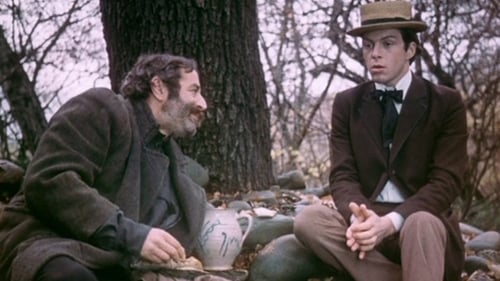
Writer
The year is 1907. The young composer Nikusha sets out on a journey over the villages of Central Georgia to record folk songs. For this he provides himself with a map of the places he would like to visit. His accidental co-traveler is Leko Tatasheli who is convinced that the composer is on a mission of the revolutionary committee and his map is the plan of a future uprising…

Writer
The way home for Aleksandr Rekhviashvili is not charted in the conventional sense. It takes the viewer along some peculiar roads and across a unique landscape: Georgian history and legend, politics and social stratification, religion and ethics. Allusive, stylized and allegorical from beginning to end, his long-banned The Way Home is in part a tribute to Rekhviashvili’s favorite director, Pasolini, especially to The Hawks and the Sparrows (1966). Together with the short film Nutsa (1971) and the widely acclaimed Georgian Chronicle of the 19th Century (1979; SFIFF 1983), The Way Home closes a triptych of films that represent Rekhviashvili’s poetic contemplation of Georgia’s past. It makes extensive use of poems by Bella Akhmadulina (the major female poet of the cultural ‘thaw’ of the ’50s and ’60s and a Georgian by descent), and of sets by Amir Kakabadze. Like other films in the trilogy, The Way Home is stunningly photographed in black-and-white.--Oxymoron

Writer
The main character, Niko (Gia Peradze) returns home after neighbors insisted he be taken to the clinic for treatment of alcoholism. On his return home Niko trying to do something to initiate the case. He wanted to work with old friends. Along with his father Nick assures that the work has begun. Also attached to the unlucky thoughts about love. After Niko lives of seriously thinking about it, things change - it would offer the neighbor woman to live together, to work and caring for her family finds.

Screenplay
Sophiko, a well-known journalist, seems to be more close to many of her respondents when they need her advice than to his family members. All engrossed in her work, she suddenly finds out that she is losing her husband who has started a love affair with another woman. Of course, it strikes her badly but life never lets her to concentrate on her personal problems.

Screenplay
The stone-cutter, Nasdika, transforms stones into works of art. The labourer, Ivané, harvests wheat in the field. The monk, Béka, paints his pictures in the convent cell. The nobleman, Kirilé, has decided to get married. The war started by enemies turns all these people into warriors. Living Legends is a parable, a hymn to the glory of the georgian people, enamoured of freedom and independence, whose most worthy sons have never hesitated to die in the name of the glorious future of their country.

Screenplay
Neighbours in a new house sometimes don't even suspect who might be living behind the wall. They're kind friends out in the street, but each of them fiercely hates the one living behind the thin wall. When will all be revealed and who will win - hatred or friendship?

Screenplay
This Soviet film is a biography of the Georgian primitive artist Nikoloz Pirosmanishvili (1862–1918), better known as Pirosmani, who died of starvation and sold his paintings to bars and restaurants for food and drink. The film experiments with color control techniques based on the painter’s style.

Writer
A critique of materialism, the film is about a young couple who live in a rundown empty apartment. Their love is so strong that it makes the water flow and the electricity work, but when they start purchasing furniture and knickknacks, they fight and grow apart.






